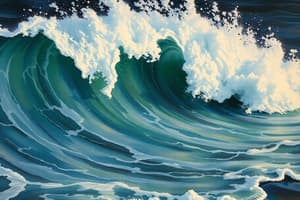Podcast
Questions and Answers
What is the definition of a mechanical wave?
What is the definition of a mechanical wave?
- A force that moves through a vacuum
- A disturbance in matter that carries energy from one place to another (correct)
- A wave that only travels through gases
- A disturbance in matter that causes vibrations
Which type of mechanical wave travels along the interface between two media?
Which type of mechanical wave travels along the interface between two media?
- Electromagnetic waves
- Transverse waves
- Longitudinal waves
- Surface waves (correct)
How is frequency defined?
How is frequency defined?
- The distance between two consecutive peaks of a wave
- The time it takes for one full cycle of motion
- The number of complete cycles in a given amount of time (correct)
- The speed at which the wave travels
If a wave has a frequency of 5 Hz, what is its period?
If a wave has a frequency of 5 Hz, what is its period?
What is the relationship between wavelength ($\lambda$), frequency ($f$), and speed ($v$) of a wave?
What is the relationship between wavelength ($\lambda$), frequency ($f$), and speed ($v$) of a wave?
Flashcards
Mechanical Wave
Mechanical Wave
A disturbance that travels through matter, carrying energy from one place to another.
Medium
Medium
The material that a mechanical wave travels through.
Transverse Wave
Transverse Wave
A wave where the particles of the medium move perpendicular to the direction the wave travels.
Longitudinal Wave
Longitudinal Wave
Signup and view all the flashcards
Period (T)
Period (T)
Signup and view all the flashcards
Study Notes
Mechanical Waves
- Mechanical waves are disturbances in matter that carry energy from one place to another.
- The matter through which the wave travels is called a medium. The medium can be a solid, liquid, or gas.
- Examples include waves on a rope, sound waves, and seismic waves.
Types of Mechanical Waves
- Transverse waves: The motion of the medium is perpendicular to the direction of the wave. An example is a wave on a rope.
- Longitudinal waves: The motion of the medium is parallel to the direction of the wave. An example is a sound wave.
- Surface waves: These waves travel along a surface separating two media. An example is an ocean wave.
Parts of a Wave
- Amplitude: The maximum displacement of a point on the wave from its equilibrium position.
- Wavelength: The distance between two consecutive crests or troughs.
- Crest: The highest point on a wave.
- Trough: The lowest point on a wave.
- Media vibration direction: The direction of motion of the particles in the medium.
Period and Frequency
- Period (T): The time required for one complete cycle of a wave. Measured in seconds (s).
- Frequency (f): The number of complete cycles of a wave per unit of time. Measured in Hertz (Hz).
- Relationship between period and frequency: f = 1/T and T =1/f
Formulas
- Frequency (f) = number of cycles / time (t)
- Period (T) = time (t) / number of cycles
- Speed (v) = wavelength (λ) x frequency (f)
Examples
- A child on a swing completes 15 cycles in 60 seconds. Calculate the frequency and period.
- The frequency of a pendulum is 8 Hz. Calculate the period..
- A wave on a rope has a wavelength of 2.0 m and a frequency of 2.0 Hz. What is the speed of the wave?
- What is the speed of a wave in a spring if it has a wavelength of 10 cm and a period of 0.2 s?
Studying That Suits You
Use AI to generate personalized quizzes and flashcards to suit your learning preferences.




